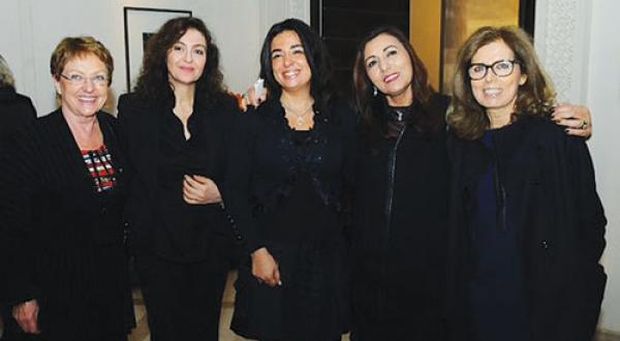
Ahlam Lemseffer, Wafa’a Mezouar, Nawal Sekkat, Leila Cherkaoui and Claudine Lavit Lahlou at the opening of their exhibition in Marrakesh (Asharq Al-Awsat)
Today, there are many more women at the forefront of the country’s plastic arts scene, with female artists from a variety of schools and backgrounds and with a variety of sensibilities winning public and critical acclaim inside and outside Morocco.
One new exhibition, Women and Art in Morocco, is on display at the Four Seasons hotel in Marrakesh, and shows off the works of seven women from different generations: Malika Agueznay, Kenza Benjelloun, Leila Cherkaoui, Wafa’a Mezouar, Ahlam Lemseffer, Nawal Sekkat, and Claudine Lavit Lahlou . The exhibition runs until February 15, and emphasizes the progress, richness and variation of the plastic arts in Morocco.
Nidal Chaouki, the head of public relations for the exhibition’s organizers, told Asharq Al-Awsat: “Choosing to hold a collective exhibit of seven Moroccan plastic artists to celebrate women and art in Morocco” was intended to showcase “the value, distinction and expansion of [the role of] women in the plastic arts in Morocco.”
In a statement to Asharq al-Awsat, Wafa’a Mezouar, Layla Cherkaoui, Ahlam Lemseffer, Claudine Lavit Lahlou and Nawal Sekkat all emphasized the value of Moroccan women’s contribution to the contemporary art world inside and outside Morocco and of the public recognition of their experience arising from that.
Although the plastic artists who participated in the exhibition were classified as contemporary plastic artists, each has their own unique sensibility. For Wafa’a Mezouar, for example, toys with color, light and shade in her paintings through the use of colors drawn from nature such as brown and red blended with a touch of blue and gold. Because she seeks to engage with what she feels are the prominent issues of the day, her paintings touch upon deeply rooted Moroccan cultural issues.
Malika Agueznay is one of the female pioneers of Moroccan plastic arts known for championing the Casablanca School, which emerged as a distinct movement that sought to take Moroccan art from simple depiction of the East to modernity and the abstract, thus rehabilitating Moroccan sensitivity and linking modernity to the roots of the past. Agueznay ’s paintings have distinct personal characteristics, as seen in the use of mosses and extremely small objects.
As for Nawal Sekkat, following a prolonged and exhausting experience in realistic art, she has moved towards more abstract elements in her work. However, she continues to mix this abstract trend with an inclination towards realism. Her art career reflects a state of continuing transformation in which symbols, denotations and values evolve. In her painting, formalistic structure intersects with fetus-like objects and immortal colors, and so the differences within her paintings remain a permanent and continued wound, reflecting a decisive attitude towards identity, existence, nature and the universe.
For Ahlam Lemseffer, color summarizes the magical aspects of life, as the pivotal aspect of beauty and a determinant of its shapes and components, as well as being a predominant part of a painting’s makeup. In her use of colors, Lemseffer relies on the empty spaces of the colors in use, even if these colors are monochrome or shades of grey. In her abstract works, the artist seeks inspiration from the land, sea and sky so that the work remains linked to pure environmental reality as well as to its identity in a clear visual frame.
As forLayla Cherkaoui , the search in her work is characterized by a search for a “poetry of light” that depicts an entire creative horizon, mixing poetic beauty with the plastic art expression of her brush through colors, mainly white and black. Cherkaoui sees that the “light wave is opened endlessly,” and so we find her drawing akin to writing a poem. Inside her paintings, one can hear tones flowing like water.
